User:Dguyj
Welcome
This landing page serves as a stash for any ideas/article drafts I might have. Feel free to contact me on Discord (Username: teinc3) for anything you would like me to add/change in the wiki.
Useful Links
Guide to Polygon CP
See also: Polygon, Control Points, Guide to CP
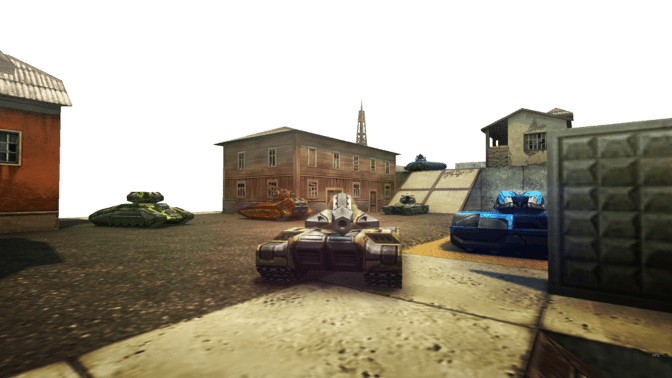
Introduction
Polygon CP has been one of the more popular and iconic battle modes on ProTanki, in which a total of 16 players form 2 teams each and wrestle control over the only point located at the center of the map. The following guide aims to introduce the tanker to identify scenarios they might face in battle and to improve their gameplay in the gamemode.
Responsibilities and Archetypes
Polygon CP is a team-based gamemode and every player must both play and coordinate well with their teammates to secure a victory. This includes selecting a proper tank combination and performing a certain responsibility within the team, referred to as an Archetype.
It is important that each archetype be represented by at least one player in a team, as having multiple archetypes provides greater strengths while covering mutual weaknesses.
The following sections outline the typical responsibilities for each player, categorized into major groups with similar purposes.
Note that the responsibilities below are only rough generalizations of a player's purpose of contribution within the game. Certain groups may be over/underrepresented or even absent from the battle, depending on the number of players who are fulfilling such a role.
| Point Cleaners | Rushers | Supporting Isidas | Mid-Field | Campers |
|---|---|---|---|---|
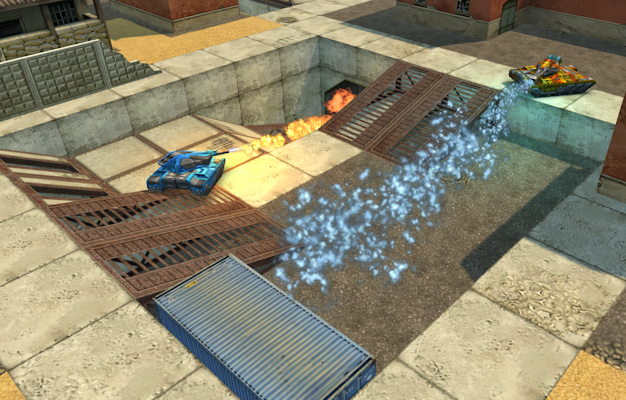 |
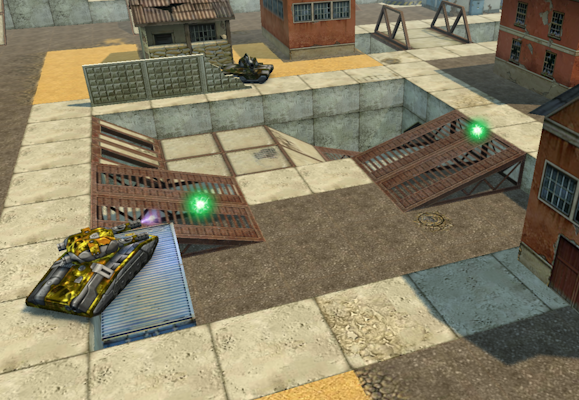 |
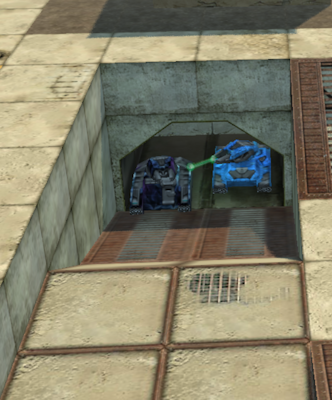 |
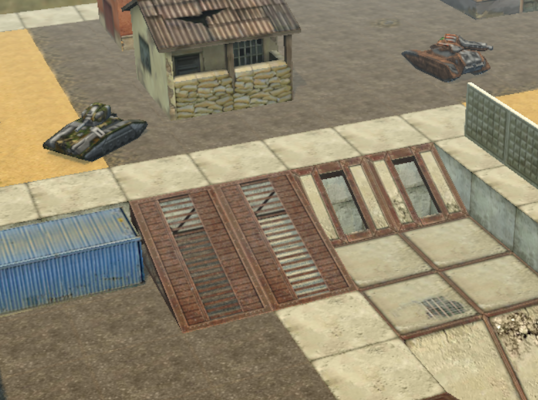 |
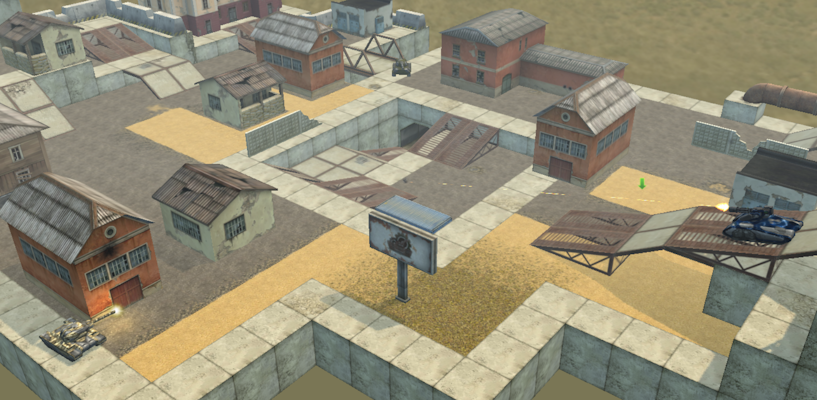 |
Point Cleaners
Point Cleaners consists of 1-2 players responsible for cleaning the control point of large enemy clusters by dealing extremely large amounts of damage on them in close range.
A melee weapon containing a cone of splash damage, and depending on the situation, a medium or heavy hull, is equipped.
Rushers
Rushers are players tasked with attacking and occupying the point from enemy control. They equip mostly short-ranged turrets, and depending on the situation, medium or heavy hulls.
Rushers are more effective at dealing with one enemy at a time, while Point Cleaners are more effective at dealing with multiple enemies clustered near the center.
A Rusher with a heavy hull can defend the control point from enemy assaults by positioning itself at the entrance ramp of the tunnel. If the Rusher is supported by Isidas inside the tunnel, a Tunnel Group is formed where the Rusher acts as the tunnel defender.
When a tunnel defender is at critically low health, it can swap positions with another Rusher with a decent amount of HP, so that the tunnel always remains fully defensible.
Supporting Isidas
Supporting Isidas consists of 1-2 Isidas mainly responsible for healing allies, although they can also act as Rushers and damage enemies in certain scenarios.
Supporting Isidas can roam around the map freely, but mostly occupy the tunnel next to the Control Point, where they continuously replenish the health of tunnel defenders defending the tunnel entrance as well as other accompanying Isidas, which helps prevent the enemy from gaining a foothold on the point.
Mid-Field
Mid-Field players have medium-ranged turrets equipped on heavy hulls. Unlike Rushers, they do not occupy the point actively, but instead position themselves at choke points near the control point.
When the point is under allied control, Mid-Field players will engage approaching enemies or campers and attempt to pick fights to distract them from going towards the point. If the point is currently occupied by the enemy and under assault by teammates, they will assist in attacking it and at times move towards the point to absorb damage from enemies.
Campers
Campers equip long-ranged turrets and position (or entrench) themselves in hard-to-access positions, where they continuously dish out large amounts of damage on enemies.
Most camping turrets are single-targeted and mainly attack enemy campers and Rushers approaching the point. Thunder is the lone exception as it leverages splash damage on crowds of enemies. Instead of focusing on enemy campers, Thunders mainly attack enemies that are grouped together and/or assaulting the point.
Campers are often criticized in battle for their “lack of contribution" as they often do not occupy the point at all. This is false, as campers are mainly responsible for damage output, and the responsibility for occupying the control point goes towards Point Cleaners, Rushers and occasionally Mid-Field players.
It is recommended to have not more than 2 campers, in which there should be at least 1 Thunder, as having too many campers will reduce the number of players that will actively occupy the point.
Turret Profiles
See also: Turrets
The following section aims to profile every Turret in the game and explain their specific responsibilities when playing Polygon CP.
Firebird
Archetypes
- Point Cleaner
Suitable Hulls
- Hunter
- Viking
Analysis
Firebird is particularly effective in damaging groups of heavy hulls due to it having the highest scaleable damage in the game. When positioned correctly, it can be used to plow through clusters of enemies at the center and inside the tunnel. Firebird can also use its mobility to sneak up on unsuspecting campers and distract them. It is very difficult for enemy campers to survive the engagement due to afterburn.
As Firebird can only store a limited amount of energy (also known as ammo) at once, knowing how to deal the most damage while minimizing losses is crucial. The damage from afterburn takes large amounts of energy to scale up, which heavily discourages relying on it when attacking medium hulls, as they are often destroyed before the damage from afterburn ramps up significantly.
Spending all energy on a target is not recommended unless facing clusters of enemies at once or when you have little HP to spare, as some energy should be reserved for dealing with other enemies that you might encounter later.
A general rule of thumb is to use a maximum of 60% of your energy on medium hulls and a maximum of 80% on heavy hulls.
The following images showcases a scenario where Firebird is used optimally:
| Step 1 | Step 2 |
|---|---|
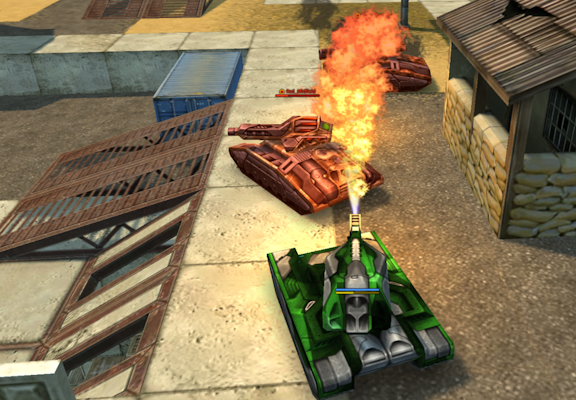 |
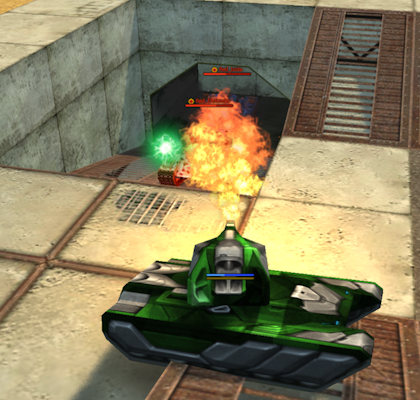
|
| The Firebird positions itself to burn both enemy titans at once. As it is close to the point, few energy will be regenerated when it moves towards the center afterwards, hence why it only uses a limited amount (~60%) on its first encounter. | The Firebird then moves towards the tunnel entrance during which it regenerates some energy (~20%). It then spends its remaining energy (~60%) to attack the tunnel. |
Freeze
Archetypes
- Point Cleaner
Suitable Hulls
- Tier 1: Viking
- Tier 2: Hunter, Titan
Analysis
Like Firebird, Freeze can deal with large groups of heavy hulls with its significant damage. However, Freeze's main purpose is to neutralize campers by distracting and freezing them into unresponsiveness. The freezing effect can also be used to slow down enemy Rushers from rushing towards the central point, where they can then be singled out by allied teammates.
As Freeze has a much larger energy clip than Firebird, it can deal damage for a longer period, and therefore needs more HP to survive to unload a full clip. In addition, Freeze's slowing effect allows the player to trade off excess speed in exchange for more health, stability, and maneuverability (required to circle around enemies). Therefore, Viking is often the top choice for Freeze.
Freeze in some ways functions like Firebird and in others acts completely opposite. As Freeze has a large amount of energy per clip, it is often feasible for it to engage in multiple consecutive battles with enemies before using up an entire clip. Freeze damage is also constant and does not scale according to time, and so Freeze users tend not to worry about energy management and maximizing damage as much as Firebird users. However, if the opportunity arises, it might still be wise to reserve some energy for attacking multiple enemies at once with its cone of splash damage.
Isida
Archetypes
- Supporting Isidas
- Rusher
Suitable Hulls
- Tier 1: Viking
- Tier 2: Hunter, Dictator, Titan
Analysis
Isida has a consistent DPS comparable to a short-ranged turret, but its secondary ability to heal allies significantly alters the dynamics of Polygon CP. However, the multi-modal mechanic makes Isida much harder to master, requiring wise decisions regarding the choice of attack or heal to maximize the turret's effectiveness.
Isida as an offensive weapon deals relatively little damage compared to its melee counterparts, and therefore is reserved only when there is a need to replenish its own health. Therefore, Isidas should almost exclusively heal teammates whenever possible. One straightforward rule is to heal a player who can counter the enemy most effectively, whether it is a teammate with good protection against current assaulting enemies, or a teammate with a lot of energy, which allows it to continue dealing damage without the risk of premature destruction. The latter example explains one of the core concepts underlying the tunnel strategy, where a turret with infinite energy and high DPS (e.g., Twins or Hammer) is healed continuously to deal infinite amounts of damage, quickly wiping out assaulting enemies.
However, when contesting the central point alongside multiple enemies, it is often a good idea to heal a teammate on the brink of destruction, instead of one with good protection or with large amounts of energy. This allows the endangered teammate to stay alive longer and continue occupying the point, making it more difficult for the enemy to neutralize or capture it. If there are no teammates with low health, consider directly damaging an enemy to secure the control point of all enemies as soon as possible.
Like most melee turrets, Isida is best suited on a medium hull that provides enough HP while retaining decent speed. Isida’s attacking mechanism lacks splash damage, which doesn’t require good positioning to begin with, so the stability of the hull is not as important, allowing Dictator to be another decent choice. However, most Isida players prefer Viking as it is fast, has much health, has a low height hitbox and is relatively stable. Some Isidas that entrench inside the tunnel may also prefer Titan, as its high health ensures survival for longer periods of time.
Hammer
Archetypes
- Rusher
Suitable Hulls
- Hunter
- Viking
- Dictator
- Titan
Analysis
Hammer’s clip contains 3 powerful shots that unleash burst damage on enemies. After releasing the shots, the clip needs to be reloaded briefly. This period of reload is used differently depending on one’s hull and playstyle.
On one hand, Hammer equipped with a medium hull can employ hit-and-run tactics by peeking out from a building or wall, shooting, and retreating back. After firing the shots and initiating the reload, they use the time to traverse corridors and ambush the enemy from another position. On the other hand, Hammer equipped with a heavier hull moves much more slowly and cannot actively take cover, rendering it defenseless during reloading. Players thus ignore the reloading time and continue straight towards their target to obtain a closer range and deal more damage when their next shot is ready.
As the distance from the enemy target increases, the likelihood of some pellets missing also increases, reducing the amount of damage dealt. In some circumstances, one or more extra shots may be required to fully destroy the target. It is thus crucial for a Hammer player to count the damage currently dealt to the enemy and adjust their position closer to deal more damage with the next shot if needed, minimizing the number of shots required.
When left with one round in your clip and no enemies nearby, release it prematurely. When you approach an enemy, the clip will be fully reloaded, giving you 3 shots to deal with your enemies, as opposed to just 1.
Besides Hammer’s unparalleled burst damage, its shots also have the highest knockback of any turret in the game, making it extremely easy to disrupt enemies' aim. This becomes particularly useful when facing high-damage turrets such as Railgun or Shaft that are currently aiming at you or your teammates. One simple shot aimed at their corners is often enough to spin their hull around significantly and make them abort their entire shot. However, some Railgun users aware of this issue will not initiate their shots until after the Hammer shoots first, to prevent their aim from being knocked off.
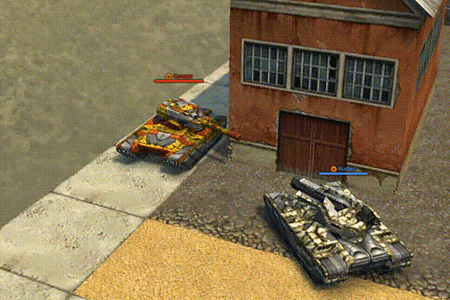
Hammers, Smokies, and Thunders shoot in a periodic manner. If in a duel with an enemy using these turrets, Hammer can disrupt the aim of enemies up to two times if timed well. Afterwards, the enemy will be much more careful not to get their aim knocked off by the third time. This is irrelevant however, as they should have already been destroyed by then.
Hammer shots are also unbelievably effective against medium hulls. Medium hulls have much less weight compared to their heavier counterparts, making them more susceptible to knockback, which changes their movement trajectory and jeopardizes their stability.
A medium hull can also be easily flipped when its base is partially (when moving down a ramp) or fully exposed to air (when jumping off a cliff or bridge), by a Hammer positioned at the bottom or sideways respectively. This is particularly common when Firebirds, Freezes, and Isidas are attacking a tunnel defended by a Hammer. Firebirds or Freezes usually approach the tunnel from the entrance, taking advantage of their cone of splash damage. As soon as they start venturing into the tunnel, they immediately get flipped from their front by the Hammer positioned just underneath on the sloped tunnel ramp. Isidas often directly jump into the tunnel and target the enemy Isidas if any, but doing so exposes their side flank to the Hammer, which flips them alongside the tunnel walls.
Twins
Archetypes
- Rusher
Suitable Hulls
- Tier 1: Titan
- Tier 2: Viking
Analysis
Twins is a short-range turret that has infinite reload, easily topping other turrets for the most damage dealt over a sustainably long period.
People often believe that Twins is a "low-skilled" turret, often referring to the analogy that Twins players just place a brick on their Spacebar to win. However, do not be fooled by this metaphor. Twins projectiles rapidly depreciate in damage as their travel distance increases, making medium-ranged combat much less effective. Combined with the fact that Twins projectiles travel slowly and can easily miss their target, the actual damage dealt in practical combat is often less than its theoretical limit.
Twins, when surviving for extended periods of time, can continuously dish out large amounts of damage. This is a feat that most melee and short-ranged turrets cannot achieve—Firebird and Freeze may give a much larger instantaneous DPS, but they will eventually run out of energy.
Due to Twins’ range constraint, it must be positioned near the control point for maximum damage and is, therefore, a good candidate for defending the tunnel. Additionally, supporting Isidas will constantly replenish the health of Twins, allowing it to continuously shoot bullets at enemies and dismantle assaults easily.
It is rather difficult to find a hull that can provide a balance of stability, health, and speed, qualities that are crucial for Twins to unleash its maximum damage potential. Consider that Mammoth moves too slowly, Dictator is too unstable for Twins projectiles to land accurately, and Hunter has too little health for sustained shooting. This leaves Titan and Viking as the only two viable hulls that Twins should be mounted on.
Twins is less effective when facing hulls with more mobility, as projectiles can be dodged easily. To improve aiming, consider using Mouse controls. This allows the turret to reposition itself to where the cursor is and continue shooting in the direction of the enemy. This also helps alleviate the problem of getting your aim knocked off when facing turrets with high impact force such as Hammer, particularly when using a medium hull.
Ricochet
Archetypes
- Rusher
- Mid-Field
Suitable Hulls
- Viking
- Dictator
- Titan
- Mammoth
Analysis
Ricochet is often thought of as an upgrade from Twins. It has much greater range, similar burst damage, and, most importantly, faster bullets that hit accurately, with a limited energy clip being the only tradeoff. People that equip Ricochet usually get good scores as it doesn't take too much skill or effort to use this weapon effectively.
Ricochet can be equipped on different hulls, which alter their playstyle, although all of them retain the characteristics of a Mid-Field turret. A Viking Ricochet may take advantage of mobility and shot range to snipe down enemy Rushers from afar before swiftly moving to occupy the point, while a Titan Ricochet may take advantage of its abundant health to pick fights with enemy Rushers and prevent them from advancing on the point.
When Ricochet finishes firing all its projectiles, it enters a phase where the firing rate and subsequently DPS decreases due to the need for reload. In this case, a Ricochet user may want to save a teammate with higher current DPS by sacrificing themselves to the enemy, by blocking the enemy and shielding the teammate.
Ricochet can be used to aggressively attack and occupy the point similarly to Twins, but it can also leverage its range to hit other enemy campers or use its bouncing shots to hit Isidas deep inside the tunnel. This ability gives their team the most valuable asset by being able to dislodge enemies from the tunnel. Note that Ricochet is only effective at dealing with a single Isida in the tunnel. If there are multiple Isidas inside the tunnel, they can heal each other, preventing the Ricochet from destroying them before it runs out of energy.
The following table illustrates a number of scenarios where Ricochet can use bouncing projectiles to its advantage:
| Attacking Tunnel Isidas | |||||
|---|---|---|---|---|---|
| From the point | From the opposite side | From the tunnel entrance | |||
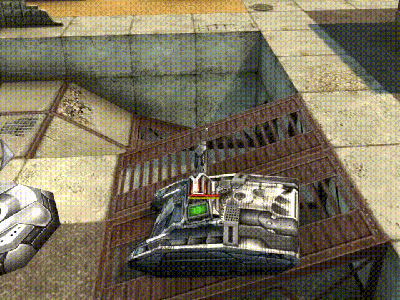 |
 |
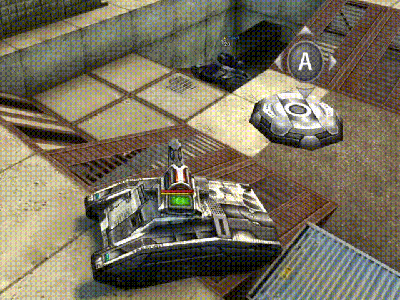
| |||
| Attacking Cliff Campers | |||||
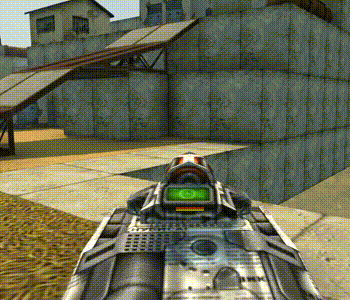 |
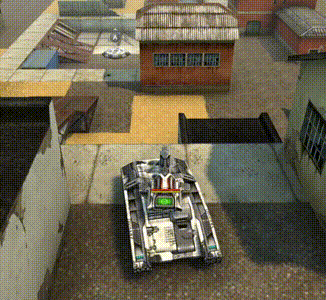
| ||||
| Attacking Top Campers | |||||
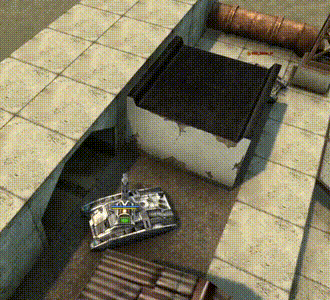 |
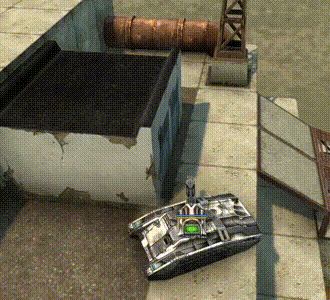
| ||||
When engaging in a one-on-one fight against an enemy Isida with full health, try to ignore the Isida and aim a few shots at other enemies first. The Isida will start attacking you and drain some of your health, but the vampire effect will not work against you as it is already at full health. When the Isida is about to run out of energy, start attacking it with your entire clip. Without energy, the Isida will not be able to replenish its health with the help of the vampire effect, and your burst damage will decimate it quickly.
Smoky
Archetypes
- Mid-Field
Suitable Hulls
- Tier 1: Titan, Mammoth
- Tier 2: Hunter, Viking, Dictator
Analysis
Smoky is usually mounted on a heavy hull so that it can act as both a Mid-Field turret and camper simultaneously. It can also be played with a mobile playstyle, making medium hulls a viable choice,but these are usually reserved for turrets with larger damage per shot and longer reload times, such as Thunder, Railgun, and Shaft.
Due to Smoky's good range, fast reload, and decent turret rotation speed, it can function well in both close-quarters and long-ranged combat. Along with Shaft (in Scope mode), Smoky has the ability to pick fights with a full-health melee enemy and survive with little health remaining. It, therefore, does not have to prioritize an escape when encountering them.
Both Smoky and Hammer have a large impact force, but it is the Hammer pellets that attract the most attention from enemies, not Smoky shots. Thus, a skilled player with good aim can focus on attacking the edges and corners of enemies to throw off their shots.
When facing off against an enemy Smoky, Thunder, or Shaft (in Arcade mode), try to time your shots so that your shot is ready moments before theirs. Then, aim at their hull's corners to knock their impending shot off. Repeat this multiple times, aiming at alternate corners to keep them missing their shots.
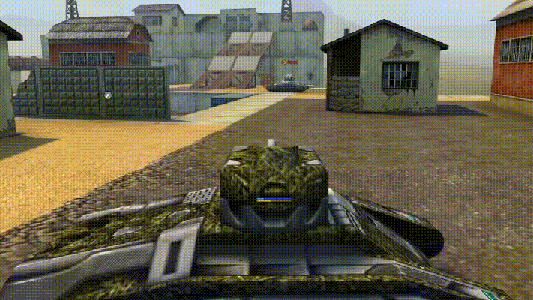
Sometimes it is recommended to skip a shooting cycle and tank a shot from the enemy so that you can re-time your shots properly and adjust your aim meanwhile. Beware of issues related to ping/latency and try to be unpredictable. For better aiming, you can consider using mouse controls.
Thunder
Archetypes
- Mid-Field (Not recommended)
- Camper
Suitable Hulls
- Hunter
- Viking
- Dictator
- Titan
Analysis
Thunder is usually played as a camping turret, but it is rather different compared to other turrets within the same archetype, as Thunder is multi-targeting while others are single targeting only.
The main objective of Thunder is to deal as much damage to as many enemies as possible while surviving for a long period of time. As its radius of splash is much larger than the narrow cone of splash of point cleaners, the presence of a Thunder focusing the center will make any coordinated assault by the enemy on the control point much more difficult.
Thunder is usually played as an assisting turret that dishes out damage, and hence there is no need for it to go towards the point. However, some players may prefer to play Thunder using a Mid-Field style by actively engaging enemies in close range. This is highly ineffective however, as the thunder is much more likely to succumb to attacks (due to its exposed position), and self-damage from close combat neutralizes its effectiveness.
Constantly look out for groups of enemies that are clustered together. Then, attempt to shoot at the exact center of the group. This will cause all enemies to lose some health unless they recognize the threat and move away from each other.
The decision on whether to shoot a cluster of enemies far away from the control point or to shoot a single enemy at the control point still remains disputed. If the group of enemies are moving together (presumably to the point) with no sign of dispersal, shoot at them first. Otherwise, you might want to finish the lone enemy at the point first.
Remember that Thunder is used to damage multiple enemies at once, not isolated campers. They are the responsibility of other turrets. As Thunder, you will be outmatched by other turrets on a one-on-one basis. Avoid shooting at enemy campers, unless you are certain they will not retaliate against your attacks, or they are low in health and can be destroyed.
The following image shows an ideal Thunder shot utilizing splash damage effectively:
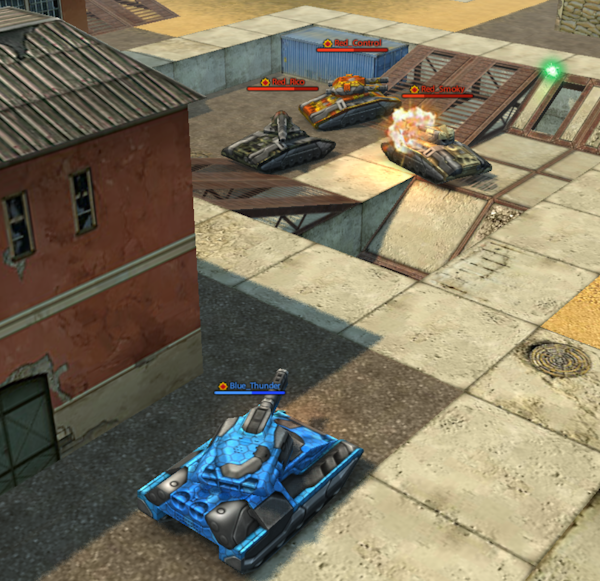
Thunder can be mounted on different types of hulls, either medium or heavy. These are used depending on different circumstances:
- Medium hull: Used when the enemy uses a lot of short-ranged turrets such as Twins or Freezes. Medium hulls such as Hunter provide enough speed to out-maneuver enemies. High speed allows for Hull Rocking allowing for better vertical aiming angle. Also known as Mobile Thunder.
- Heavy hull (Titan): Used when the enemy uses a lot of long-ranged turrets or those with high Knockback such as Smoky and Hammer. Speed is less effective as you can't usually outmaneuver a long-ranged turret. In this case, a heavier hull provides better stability and horizontal aiming. Also known as Static Thunder.
Playing a medium hull requires substantially more effort and attention than playing a heavy hull, but when played correctly can yield much greater rewards (by being able to survive for much longer). An ideal playstyle would involve “Hit-and-run" tactics, where the player lands shots and then gets out of sight of enemies to prevent retaliation. The player would also have to constantly look at surroundings and escape when threats are incoming.
If playing a heavy hull, note that your movement options are extremely limited. Attempt to camp near the Top, the bridge or the house near the billboard, as these are positions which can both oversee the point and are relatively hard to reach for enemies. Avoid camping near the Island (opposite side of the Cliff) as it is too far away to the point where the majority of enemy clusters form. When provoked by enemies with short-range turrets, position yourself in direct sight to the point so that you can keep shooting at prioritized targets.
A more detailed strategy guide regarding good camping positions and escape routes can be found further into the guide.
Vulcan
Archetypes
- Mid-Field
- Camper
Suitable Hulls
- Tier 1: Titan, Mammoth
- Tier 2: Viking, Dictator
Analysis
Vulcan is a turret that has many unique advantages and setoffs. For one, it can continuously fire at one of the highest damage rates amongst all ranged turrets, making it highly effective at dislodging heavy hull campers from entrenched positions alongside Smoky, an alternative.
However, firing excessively will cause overheating to the hull, which speeds up the demise of the player. In addition, turret rotation is controlled by a gyroscope, and its speed is reduced significantly when shooting, making closed-range combat with melee units especially difficult.
The decision of whether or not to shoot into overheating depends on the current situation in battle. If the enemy is bitterly contesting the control point against your teammates, the extra damage from you at the expense of slightly reduced health might alter the situation and help your teammates hold the point successfully. However, if the enemy is poised to overtake the control point with an overwhelming push, then the extra damage you dish out is not significant enough to alter the current situation. In such a case, it is recommended to stop shooting, reload and continue afterwards, as the total amount of damage you deal to the enemy will be much greater at the end.
When attacked by an enemy with high damage, try to shoot into overheating. The health you lose from overheating is usually much less than the amount of damage your enemy is dealing on you. If you stop shooting, however, you lose the opportunity to damage the enemy before getting destroyed, as reloading takes a long time. However, at low health, it is not recommended to continue shooting unless near the presence of an enemy, as overheating will trickle down your remaining health and destroy you.
As Vulcan has a slow turret rotation speed while shooting, it is particularly vulnerable to close-quarter combat. Hence, identifying encampment positions that are difficult to access is especially important. Ideally, such a position can only be accessed from 1-2 narrow corridors, so that melee units cannot circle and outflank the Vulcan from behind.
Railgun
Archetypes
- Camper
Suitable Hulls
- Wasp
- Hornet
- Hunter
- Viking
- Honorary Mention: Titan
Analysis
Railgun has the second largest damage per shot in the game, only behind Shaft in Scope mode. This makes Railgun primarily a camping turret focusing on delivering high damage punches to heavy hulls by draining most of their health such that they can be finished off by teammates.
Attempt to identify enemies with around the same or significantly more health than a Railgun shot, or ones that are lined up vertically so that a shot can penetrate all of them at once. Beware that damage may be wasted when shooting at an enemy already at critically low health. The possibility of missing a shot is also highly likely due to Railgun needing to warm up before firing a shot. With Railgun having a lengthy reload, missing a shot will only dampen your team's effectiveness, and so spending time planning your targets and shots ahead is highly recommended.
Having a good position is crucial for Railgun so that it would be able to grasp opportunities to attack multiple enemies at once through penetration damage. This usually occurs when multiple enemies line up near choke points moving towards the point, and the Railgun peeks out from a corner and penetrates all of them. As Railgun is virtually defenseless when reloading, it also needs to prioritize an escape when facing all types of enemies. With positioning and mobility being the number one priority, Railgun is best mounted on a Medium or even Light hull, with the latter being the only time someone should mount a Light hull in Polygon.
Shaft
Archetypes
- Camper
Suitable Hulls
- Tier 1: Hunter
- Tier 2: Viking, Titan, Mammoth
Analysis
Unfortunately, Shaft in Polygon has one of the steepest learning curves out of any turret in the game, and most players that use it often lack in-depth knowledge on how to operate the turret to its finest in such a battle setting. The mere mention of using Shaft in Polygon is often ridiculed as a joke or frowned upon by teammates when the player is serious about its usage.
Like Railgun, Shaft is indisputably a camping turret and so the main objective is to stay alive as long as possible so that you can deal as much damage to enemies. Similarly, damage should be dealt to critically drain enemies' HP so that they can be finished off by teammates with ease. There is usually no need to go to the center where the point lies, as Shafts do not typically do well in close-range combat.
Shaft is unique in that it has access to two different modes: Scope and Arcade. Scope shots deal the most damage per shot out of all turrets in the game, and are reserved for dealing with high HP enemy hulls, as scoping a low HP enemy just wastes your energy. Arcade shots deal smaller fractions of damage for faster recharging and are used to finish off enemies with less health.
After respawning, you should have full energy and can immediately start a Scope shot. Identify an enemy with sufficient health so that little to no damage will be wasted, then unleash a full Scope shot at it to wipe out most of its health. Depending on the enemy archetype, you may want to keep putting follow-up shots until the energy bar refills, then repeat the process by making another Scope shot.
| Scope Shot | Arcade Shot |
|---|---|
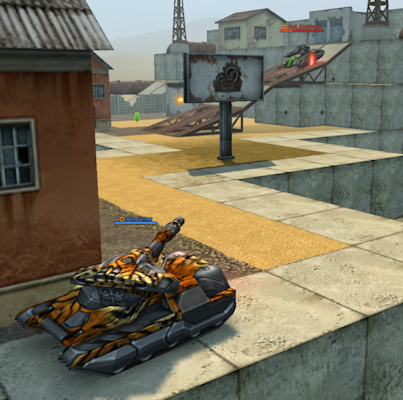 |
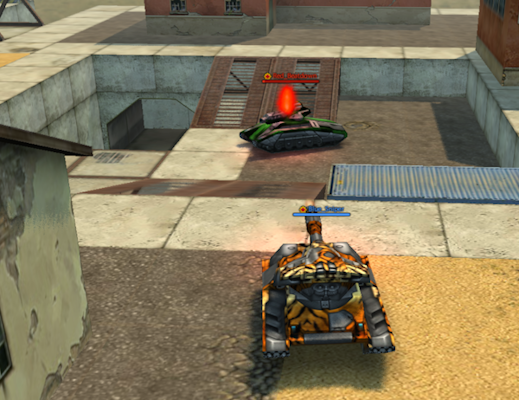
|
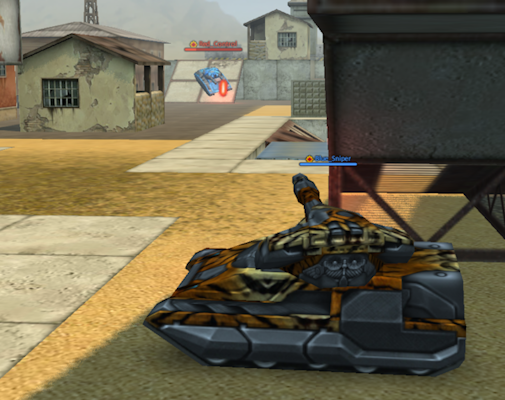 |
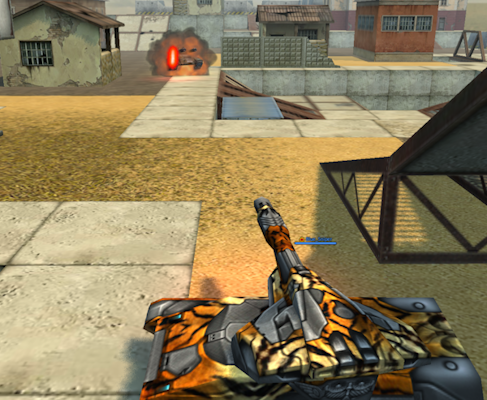
|
As Shaft’s responsibility exclusively involves damage dealing, minimizing damage lost due to overshooting becomes highly important. When uncertain whether the enemy is at full or little health left, do not take the risk with a scope shot. Simply resolve to firing multiple Arcade shots, which makes damage loss much less significant.
Always attempt to destroy enemy campers completely as they are effective at all ranges, and which can also retaliate against you. However, you should try to leave some health left for enemy Mid-Field and Rushers if they are far from the point or any teammates. After wasting time traveling across the map, the affected enemies will arrive at places of interest, in which you or your teammates will make the final death blow before they have a chance to do anything at all.
While it is recommended to deal a full blow to Titans at full health, it might be more beneficial to prematurely fire a scoped shot at Vikings and Hunters, so that the follow-up shot (which can also come from teammates) can come quicker.
| Recommend Damage Dealt | |||
|---|---|---|---|
| Hull | Hunter | Viking | Titan |
| Health | 285 | 315 | 420 |
| Scope Damage | 200-240 / 285 | 235-280 | 302 |
| No. of Arcade Shots | 0 / 1 | 0 / 1 | 1 |
| Total Damage Dealt | 285 | 315 | 390 |
Shaft, like Railgun, can deal damage to multiple enemies lined up in a row. When aiming in Scope mode, try to identify enemies situated right in front and back of each other, then move the crosshair accordingly so that the shot penetrates all of them. It is much harder to hit multiple targets when in Arcade mode due to auto-aim, but it can still be worthwhile to perform, especially when enemies are clustered at the center.
When Shaft enters Scope mode, it has to remain stationary until firing the shot, potentially exposing itself to enemy fire knocking off its aim. With stability being the most important issue, Shaft does not pair well with light hulls, unlike its counterpart Railgun. Note that mobility is also an important factor for positioning and escaping, encouraging the usage of Medium hulls. Despite this, Shaft on a heavy hull can also deem effective, as it is durable enough to withstand a significant amount of damage right before a fully-charged scope shot decimates the attacker.
The Ultimate Guide for Campers
Escape the Top
Imagine camping at the top of the cliff, railing enemies one by one casually. And then comes a Firebird out of nowhere, burning you to a bright red and you perish in seconds. For an inexperienced camper who just got used to the open field the top has over much of the map, this might initially seem annoying to deal with. However, fear not! By knowing your options and planning, you can proactively dodge these nuisances and continue your fruitful camping journey!
Precautions
As a camper you should be highly proficient in aiming and spotting enemy targets, and not just in front of you but also those behind or on the sides.
By using Mouse Controls, you can use the Right Mouse Button to lock your turret in place while moving your camera to scan the environment and detect possible threats. Locking the turret rotation to keep facing the front is particularly useful as Camping turrets usually have low turret rotation speeds - it takes much time to rotate your turret to scout your flanks and then back front.
If you find an enemy close-by moving in a non-standard way, observe it carefully as there is a possibility that it is taking a detour to attack you from your flanks unsuspectingly. Act if needed.
If camping at the top of the cliff, you may also want to consider positioning yourself close to the edge of the cliff. When an enemy is spotted approaching the flanks, a decision can then be quickly made to jump down the Cliff (see next section for a detailed implementation) and escape without harm.
Disengagement
The following image shows some possible escape routes in which a camper can take:
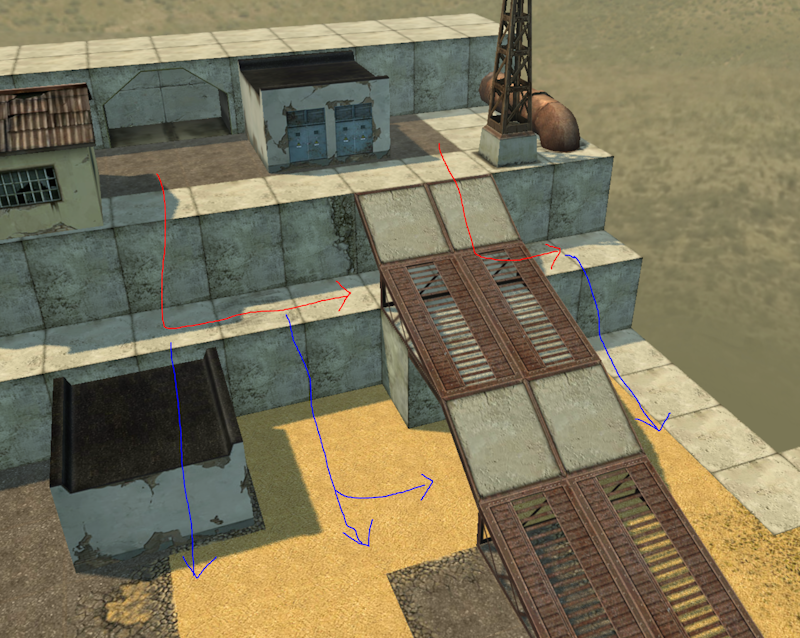
This disengagement plan should be foul proof if performed immediately after identifying the presence of an enemy.
However, if the enemy shoots you in the air with a turret with high knockback (such as Twins, Ricochet, Hammer, Smoky or Railgun), there is a significant chance that you will end up flipping over. In this situation, avoid jumping directly over the cliff or take a detour by dropping off from the bridge onto the cliff.
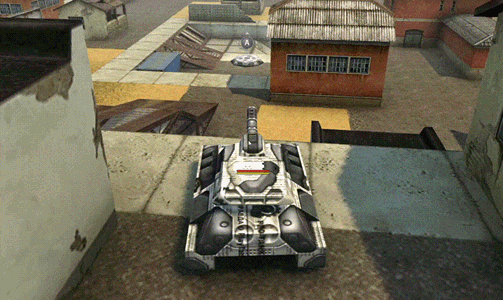
Abandoning teammates
Suppose one day you and your teammate are camping on top, shooting at enemies attacking the control point. Suddenly a Firebird spawns behind you and poses itself to attack you. But you, having read the guide up to the last section, know how to escape the top! You take action immediately, jumping off the cliff and land to safety, but the Firebird then goes to attack your teammate who perishes in seconds. You ask yourself: Should I have left my teammate to demise, or should we have ganged up on the Firebird together? It's a good question to think about, but the answer is more complicated than it seems.
Thunders are highly fragile in close combat due to self-damage, but are much more valuable on the battlefield than other camping turrets as they can deal splash damage. Therefore, their escape should be prioritized to ensure maximal survivability and control over the central point. Other turrets like Smoky and Shaft (in Scope mode) can shut down medium-hulls relatively easily, and so can initiate a combat directly against the enemy, acting like a Mid-Field unit. Vulcan's gyroscope makes it hard to control in close combat, and it has a slow turret rotation speed, but its high damage and hull combination with a large pool of health could allow surviving a melee fight with some health remaining.
Frontier and Backend Positions
Different camping turrets function under two effective ranges and each have different purposes. Close shots should target enemies assaulting the point. One shot gives less damage and is used to deal the final death blow to the enemies. Examples include Thunder and Shaft (in Arcade mode). Long shots should target enemies further away from the point and are used to trickle away their health as each shot gives much more damage. Examples include Vulcan, Railgun and Shaft (in scope mode).
Close shots, as its name implies, require positions that are relatively closer towards the control point, as the shots need to be directed towards enemies on or near the point. Long shots, on the other hand, do not require such close positions - they are dispersed far away from the map, as the camper only needs to damage reinforcing enemies that are approaching the point, without having to attack enemies near the point at all.
Note that the top area provides significant elevation to the camper and therefore negates the issue of close shooters being unable to target enemies near the point due to insufficient height. In fact, the top area is often populated by multiple campers at once, due to these favorable conditions.
The map below outlines some ideal camping spots for both Close and Long-Shooting camping turrets:
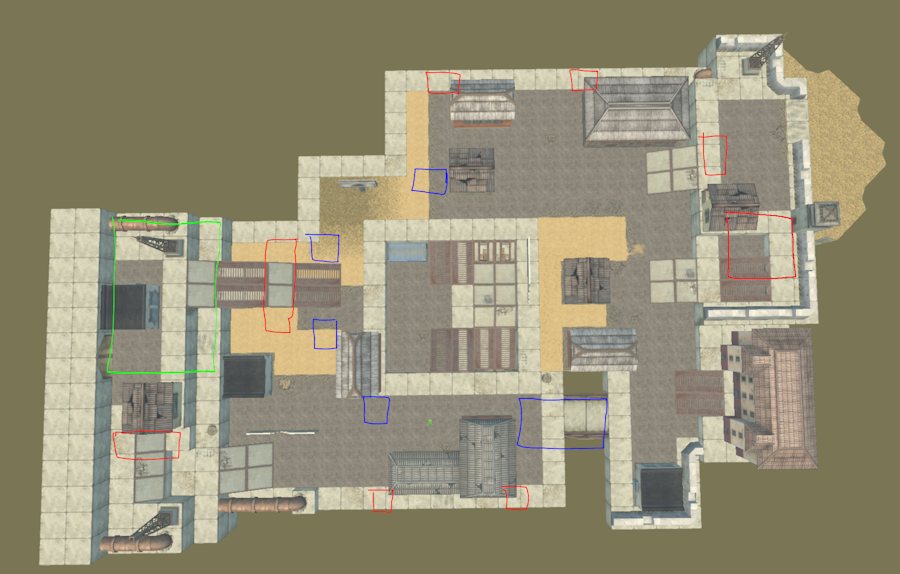
Legend:
Long
Short
Top Area
Hull Height
Players may notice that both Hunter and Viking have similar statistics. Hunter has slightly better speed, and Viking has slightly more health and stability. Players are more likely to believe that Viking has relatively more benefits than Hunter, and thus commit to it when selecting a Medium hull.
However, many people fail to realize that the height of the hull is also an important characteristic when factoring in the optimal hull choice. And in Polygon CP, where control over a single area situated slightly beneath ground level is absolutely crucial, the difference in height can have a significant impact on the playstyle of each turret.
Viking has a significantly lower height compared to Hunter. When situated in a Long-Shooting position, the turret is unable to propel shots into the center, and can only attack enemies on the ground level. Hunter, on the other hand, gives a small height boost, which allows camping turrets to aim at tanks inside the sunken area where the point lies at a better angle.
As a Railgun player’s main objective is to deal heavy damage to full-health tanks continuously and not to finish off weakened players near the central area, height is not a concern allowing Viking’s other qualities to shine. However, Thunder’s splash damage and Shaft’s arcade shots are usually aimed within the depressed point area, and therefore, having enough height to aim shots afar gives Hunter the edge in this scenario.
These qualities can prove useful for other melee turrets as well. When positioned on the edges of the point (at ground level) and attacking enemies at the point (at the depression), the Firebird and Freeze damage cones get into closer proximity with the enemies when using a hull with a lower base height. This dishes out more damage to the enemies and is the main reason why Viking and Hunter are preferred more often than Dictator when using short-ranged turrets.
Tunnel Interactions
Holding the Tunnel
When the tunnel is under attack by enemies, the Defender can attempt to hold the point and stall the enemy offensive due to the tunnel entrance being near the control point.
Note that the Defender usually has a heavy hull mounted, and when destroyed can take a significant amount of time before returning to the tunnel. Therefore, it is usually the best option for the Defender to retreat into the tunnel when the enemy offensive is too overwhelming. When reinforcements from teammates arrive and the coast is mostly clear, it can then come out of the tunnel to recapture the point.
Tunnel Isidas, on the other hand, usually equip Viking due to its high mobility and moderate health. When a tunnel Isida is eliminated, it can then traverse swiftly through the map and re-enter the tunnel, recreating a proper defense.
Viking's low height allows for a small enough hitbox. This, accompanied with a large hitbox of the Defender's heavy hull, allows effective protection from enemy fire. The Defender should also reposition itself when needed to provide maximum shielding for the tunnel Isidas. Still, there might be select circumstances where it is better to allow Isidas to take the hit, as they are easily replaceable and often have more than enough HP to spare.
Attacking the Tunnel
Under most cases, gaining control over the tunnel gives a decisive advantage for their team. For the other team, it becomes crucial to dislodge the tunnel of enemy defenders.
In general, the difficulty of dislodging a tunnel depends on the number of supporting Isidas present in the tunnel, as the more Isidas there are, the harder it is for the tunnel to be cleared. However, overcrowding of the tunnel may result in a less efficient defense formation, and it allows splash damage to affect many tanks at the same time.
The more supporting Isidas there are, the lesser the damage that can be dealt by reinforcing enemies. The pace of enemy reinforcement simply cannot outmatch the pace of friendly reinforcement, making it much easier to neutralize the tunnel and occupy the control point without having to completely dislodge it from enemy control.
Prerequisites
When attacking the point, many teammates will coalesce together, which makes splash damage particularly effective in shutting down massive pushes. The Defender may try to lengthen the time the attackers need to capture the point, and in doing so, the attackers sustain much more splash damage and get destroyed en masse, causing the attack to die down.
Before mounting an assault on the point, be sure to destroy or neutralize enemy Thunders. Position your hull in front of them to block their shots so that they get self-damaged and die. Allow the Thunder to sustain as much self-damage as possible while you attack other enemies, until you dip below 50% HP, then switch targets on the Thunder and destroy it. When the Thunder respawns, the fight for the tunnel would most likely be over, and it would likely be placed in a terrible position that disallows hitting friendly point assaulters. You should also prioritize all approaching Firebirds and Freezes so that they cannot contest the point while wreaking havoc on the assaulters with their cone of splash damage.
If difficult to reach, it is possible to ignore single hitters like Vulcan and Railgun altogether, but a better approach is to distract them into a dogfight with another tank that is much further away from the point. This ensures that the enemy's supporting fire cannot be used against the tunnel assault team. The tunnel defenders cannot receive reinforcements and will quickly die.
Single Isida
A lone Isida in the tunnel cannot heal itself, making it much harder to stay alive when sustaining enemy fire. With only a Defender and an Isida, the tunnel becomes much more spacious and navigable to dropdown assaults as well as Ricochet projectiles. Thus, the general objective is to first destroy the supporting Isida before destroying the Defender.
A player with Ricochet can aim its shots at the edges of the tunnel so that the projectiles bounce deep into the tunnel and damage the Isida. Even by equipping paints with protection against Ricochet (such as Nano), the lone Isida will still succumb relatively quickly. If there is only one Defender and one supporting Isida, one side of the tunnel is usually exposed. Smoky, Thunder and Vulcan can then shoot into the tunnel flanks from surface level, damaging the Isida.
A player may also equip Hammer or Twins, fall from the top of the tunnel entrance, and deal burst/sustained damage to the Isida. The Isida is usually unable to damage the player and heal itself, as it has spent most of its energy healing the Defender.
Multiple Isidas
When there are 2 or more supporting Isidas in the tunnel, it becomes possible for them to heal each other even when sustaining enemy fire. The Defender can also receive twice as much healing support, making it much harder to destroy the Defender first before singling out the Isidas. Therefore, a much more complicated task force that can dislodge the tunnel in an overwhelming push is required.
If positioned correctly at the entrance of the tunnel, Point cleaners such as Firebirds or Freezes may cause large amounts of damage to both the Defender and Isidas due to the cone of splash damage. If using Freeze, a supporting Isida is generally recommended as Freeze can sustain damage over a much longer period without depleting its energy. Firebird is also a good choice as its damage ramps up quickly due to afterburning, making Isidas much difficult to survive while supporting the Defender.
A Railgun can penetrate both the tunnel Defender and the supporting Isidas in one shot. The shot is usually done after the Point cleaner has done a large amount (but not enough) damage to the enemy Tunnel Group, as it gives a high amount of burst damage and can usually wipe out both the Defender and a supporting Isida at once, cleaning the tunnel much more easily.
A thunder can also incline itself against the sloped walls on the edge of the tunnel and propel shots deep into the tunnel. This causes splash damage to both the supporting Isidas and the Defender. However, such a move can be highly dangerous, as the hull is exposed directly to supporting enemy fire. Knockback from the Defender can also potentially flip the Thunder, making it useless for a long time.
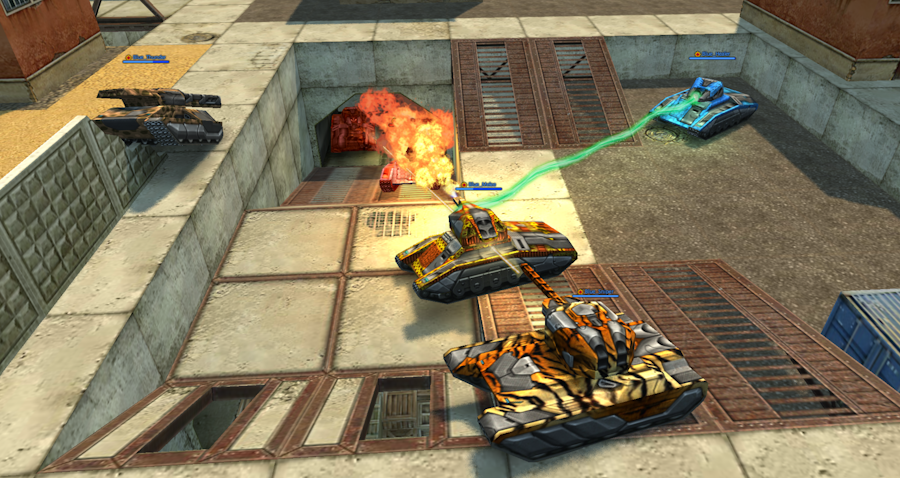
Beware that defending hammers may attempt to use their rounds with high impact force to knock off the aim of the assaulters, and in cases even flip them over. To mitigate this, the point cleaner can equip Titan instead of a medium hull, so that the impact force becomes less significant, although this move is still unnecessary for experienced players. The Railgun can also position itself behind the point cleaner, so that it can penetrate shots accurately into the tunnel without having its aim knocked off.
Coordination and Protections
Scenario
In a popular scenario that most can relate to, the Red team has 3 Thunders. The Thunders keep vigorous control of the point and dominate the game. In Blue team's chat, one suggests that people change to Emerald to take advantage of the 50% protection against Thunder. 3 people with Nanos then proceed to change their paint to Emeralds. Red counteracts by changing their Thunders to Ricochet, continuing their dominance over the game.
In an ideal case, the Red team should change its paints gradually so that the Blue team cannot counteract immediately using a different strategy.
This example shows us that coordination inside the Red team is poor, leading to overreactions.
When changing Turrets or Paints, express your desire in the team chat and ask for confirmation from others. Refrain from changing immediately as other teammates that do not respond in chat may also change their turrets. In this case it becomes unnecessary for you to do so.
When enemy campers become entrenched, your team may find it difficult to assault the control point. As a reader of this guide, you understand the dynamics of the battle and know that under this situation the best solution is to kill the campers before continuing. You can therefore guide your team by giving them strategical instructions, such as to focus on killing campers first.
Natural Hull Protection
Different types of hulls give rise to different speeds, health and stability, and may be subject to certain weaknesses due to such parameters.
For instance, protection against melee turrets are not as effective on medium hulls than on heavy hulls, as the medium hull can easily outrun them, and the effort needed to chase them is simply not worth the potential damage that can be dealt on another heavy target. However, turrets with high knockback deal with medium hulls relatively well, as it can significantly disrupt the movement of the hull. A long-ranged turret has a lower DPS compared to a short-ranged weapon, and thus requires much more time to neutralize a heavy hull (under normal circumstances) than a melee turret.
These base interactions between turrets and hulls contain both advantages and disadvantages. If the interaction is advantageous, our playstyle gives us natural protection from that turret and we do not need to consider its protections when selecting our paint. If the interaction is disadvantageous, we might want to pick a paint containing protections against the group of turrets, so that it becomes much harder to naturally counter our playstyle.
An example involving Hunter, a medium hull:
- Hunter is particularly weak to turrets with high damage per shot or high knockback, common ones such as Hammer, Ricochet, Smoky and Railgun (Thunder is also widely prevalent, but does not help us illustrate our example, hence omitted.)
- Hunter’s mobility allows it to outpace melee enemies with Viking, so protections from those are naturally acquired and unnecessary.
- In such a case, equipping Tiger or Nano will discourage high-knockback turrets from attacking us, minimizing our exposure to enemy fire.
Another example involving Vulcan on Mammoth:
- Mammoth is very slow and cannot escape from melee turrets, making sneak attacks especially deadly. Firebird with its scaling afterburn as well as Freeze and Twins can destroy Mammoth in seconds due to their high DPS, while Hammer only requires 4 shots.
- Enemy long-ranged turrets need many shots to fully destroy Mammoth. Smoky and Thunder’s damage decreases over range, while Vulcan will overheat and potentially self-destruct in a duel. Railgun cannot lob 3 shots on Mammoth without exposing itself in open field for a significant amount of time.
- In such a case, by equipping paints protecting against short-ranged turrets, the threat from them becomes effectively neutralized, and natural protection from Mammoth’s extensive health pool allows us to survive for extremely long periods of time against long-ranged turrets.
Sometimes the turret choice can also contribute as a factor. Note that the above example only applies to Vulcan on Mammoth, as Smokies and Shafts on Mammoth have the ability to neutralize melee enemies, even though in such a case both players will destroy each other and no natural protection is acquired.
Broadly speaking, medium hulls are more susceptible to damage from turrets with higher burst damage, while heavier hulls are more susceptible to damage from shorter-ranged turrets. This is why medium hull users often equip Africa, which gives protections from both Thunder and Hammer.
General Strategies
- When using a ranged turret to attack a point with multiple enemy melee units, Rushers should try to remain some distance by first shooting the enemies from afar, and only entering the point once most of them have been neutralized. For Point Cleaners without protection or significant health, this act might be suicidal. It is best to let heavy-hull Rushers soak up some damage before sweeping in from another angle to neutralize the enemies.
- If you respawn on the island part of the map (opposite to the cliff area) with a short-ranged turret on a heavy hull, you may want to first self-destruct into the void so that you find a better spawn point closer to the central point. If there are enemies nearby, try to pick a fight and time a self-destruct right after you deal a large amount of damage on them.
Madness Farming
See also: Crystals, Crystal boxes, Madness, Crystal Farms
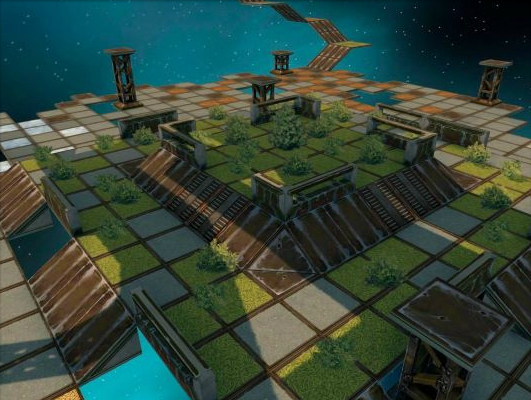
Introduction
The second-fastest way to gain crystals in «ProTanki» is to engage in Madness Farming (The fastest being to purchase from the Shop). In Madness Farming, a small group of players (usually around 8) play battles where the goal is to destroy enemies as fast as possible. This in turn generates battle fund and crystal boxes which the players take themselves.
Terminology
In Madness Farming, a session of farm is called a Cycle or Circle. In a cycle, every participating player gets one round each. Rounds are battles that last 15 minutes, and all crystals and golds generated in that period are left to the player that is affiliated with the round (who can decide if they take it themselves, trade some of it with other players, or give it out to another player for free). Every player must commit to completing an entire cycle and play equally for all rounds, not just those that belong to them.
Lists determine the order in which players receive their rounds in a cycle. Players who are new or have worse karma (typically from sabotaging other player’s rounds, causing unfinished debt or inability to complete a full cycle) are usually placed last in the list, and the rest of the positions are usually randomized with a Random Number Generator. A list is usually prepared right after the roster of players are finalized.
Timeline
Starting Phase
Time
- 15:00 - 14:45
Playstyle
- Join the battle if you are still not in it.
- For TDM, you can join the team with less players to balance out the battle.
- For a new cycle, the List is usually generated at the start of the first round.
Shooting Phase
Time
From:
- 15:00
To:
- 3:30 (For Crystal Collector)
- 0:30 (Rest of the players)
Playstyle
- Do not hide nor camp and do not stay in the top zones. Players need to be killed actively to generate fund.
- Do not go to the ground if none of the Crystal or gold boxes belong to you. For public battles self-destruct or fall into a pit. For private battles you can re-join the game unless the battle is almost ending, and you are responsible for taking the battle fund.
- Do not use or pick up Med-Kit or Double Armor unless you are volunteering and will not take a round yourself.
- Try to avoid killing a player in the enemy team solely by yourself. Instead, try shooting as many enemies as you can. In TDM, when multiple teammates assist in destroying an enemy tank, the battle fund increases by 50%.
Collecting Phase
Time
From:
- N/A (To players that will not take any crystals during the round)
- 3:30 (For Non-trading, Crystal Collectors)
- 2:30 (For Trading, Crystal Collectors that do not take the top)
- 1:30 (For Trading, Fund Takers that only take the top / Gold collectors)
To:
- 0:15 (Collectors that do not take fund)
- 0:00 (Collectors that also take fund)
Playstyle
- Here the sole objective is to take crystals boxes. There is no need to shoot at others while collecting, as that will only slow you down.
- Announce that you are collecting in Chat and take full drugs to protect yourself from other players and speed up the collecting process.
- Follow pre-planned routes to maximize efficiency during collecting.
- For players that are new to farming or have network issues, start collecting 30 seconds earlier.
- For collectors that will not also take the battle fund, consider rejoining the battle on the team of the fund taker before collecting if it is private. As you are at 0 score/kills, you can collect up to the end of the battle without having to worry about missing the timer to rejoin.
End
Time
- 0:30 (Private battles)
- 0:15 (Public battles)
When to NOT leave/rejoin the battle
- If you will take the battle fund
- If you are playing a public TDM battle. Here you should close the game window instead of leaving the match. There is a two-minute cooldown that allows your spot to be occupied so that random players cannot hijack in, even when you are not physically present in the battle.
Playstyle
- After rejoining, you are not allowed to shoot at anyone, but you are allowed to take up any remaining crystal boxes that the collector has forgotten to take (Usually near the top)
- In TDM, always join the team that the fund-taker is in, so that no fund will be split to the other team and wasted.
- It is a good practice to type “timer” in chat at the 30 second threshold to remind other players to rejoin the battle.
Equipment
To maximize crystal yield, players must use the following equipment in battle. Players will be asked to change their equipment or leave the battle if they cannot confine with the standards.
Turrets
Main article: Turrets
The idea is to pick a turret which has a good range, is easy to aim and has the highest DPS. Thunder and Smoky are the most popular, but players are free to choose one of the following weapons below:
An additional rule in Private battles is that players are not allowed to have more than approximately 25% (this number was never verified) Tier 2 weapons comprising the total turrets distribution. This will cause the battle fund to not grow as fast as normal. For an 8-player battle, no more than 2 people can take Railgun and Shaft. For a 5-player battle, the allowance limit shrinks down to 1.
Hulls
Main article: Hulls
The idea is to pick a medium hull that has the lowest amount of HP. Whether it is an M0 or M3 does not matter, just pick one with the least amount of HP. This helps other players destroy you quicker allowing for more fund.
The most popular choice is Hunter due to its less-than-average HP, height, and stability. Its speed is also an excellent choice during collecting, making a change in hulls unnecessary. Do not take Wasp or Hornet as they generate 20% less fund than any other Hull.
Paints
Main article: Paints
Do not use any paint with protection against any of the turrets listed above unless you are using a low-HP/low-level hull and find yourself dying too fast to be able to shoot back properly. In this case, you are allowed to pick a paint that gives moderate protection.
Creating a Battle
Battle Settings
Main article: Battle Settings
The following settings must be manually configured in a Madness Battle:
- Usually TDM as battle mode
- PRO-Battle ON
- Autobalancing OFF
- Private battle ON
And the following settings do not need to be changed:
- Max team size of 16
- Rearm, Crystal Boxes, Extra Boxes and Supplies ON
- 15-minute battles with no ending condition
- No Special Formats
- No Friendly Fire
Sometimes, battles may be held in public which allows players to complete Missions. The following settings will be altered:
- DM as battle mode, if the number of players participating is not an Even number, otherwise TDM
- Private battle OFF
- Max Players as the number of players / Max team size as the number of players divided by 2
Rank Brackets
Main article: Rank Brackets
Players with a wide discrepancy in ranks can still play in the same battle, provided their ranks fit within a common Rank Bracket.
The largest rank bracket consists of Major to Generalissimo, and these battles can be created by players above Marshal Rank. Smaller rank brackets can be made for players below Major Rank, but higher ranks may not be able to join the battle, which decreases the amount of battle fund.
Optimal Round Length
Compare 4v4 with 15-minute rounds to 5v5 with 12-minute rounds. Both span around 120 minutes (2 hours) but the 4v4 gives out more crystals at the end. We ask the question: why?
Fund Contribution
If each person takes 3m30s to collect all crystal boxes, then in a 4v4 the total amount of time wasted on collecting (unable to shoot and contribute to the battle fund) becomes 28 minutes in total, but in 5v5 it becomes 36 minutes. If a player spends less time on shooting, they get less fund. Common sense.
Proportion of Available Crystal Boxes
Note that in a 5v5 with 12-minute rounds, the amount of battle fund generated per minute is much greater because of more players, which means more crystal and gold boxes are being given out per minute on average.
If a gold starts to drop after 1m30s left, nobody will be able to catch it reliably. So, for a 4v4 with 15 minutes, the percentage of golds "lost" this way is 1m30s/15m = 10% For a 5v5 with 12 minutes per round, the percentage lost is 1m30s/12m = 12.5%, which is larger than its 15-minute counterpart.
Crystal boxes keep generating as long as people keep shooting (which only stops at 30s left on the timer). Suppose the player also starts collecting at 3m30s, then out of this period (3m30s-30s) there will be some extra crystals that are still being generated that the player will not be able to collect, assuming the player goes to each Crystal pile only once. The number of crystals that are generated during this time period that we can still get from each pile during this period of collection can be modelled as a triangular distribution. The rationale here is that we visit some piles late and take most of the newly generated crystals, and we visit some early and leave, missing out on the newly generated ones, so we can average out the amount we will get by dividing the total amount generated by 2. Since density of fund is much larger with more players, crystal boxes tend to drop much faster, so the amount lost in the triangular distribution is also much larger, leading to more losses.
Assist Kills
The chance of making assist kills increases at a rate of diminishing returns as the number of players on each team increases. It is likely that in a 2v2 scenario players will have to deal kills without assists, as waiting for teammates to respawn and complete the kill takes too long and ends up being less profitable than simply taking the kill oneself. This situation becomes highly uncommon in 4v4 rounds and the extra efficiency gained in 5v5 rounds becomes negligible, so there is no practical loss of fund when switching from a 5v5 to a 4v4 cycle.
Conclusion
12-minute rounds are less efficient when compared to 15-minute rounds, which are still better than longer round lengths as crystal boxes despawn after 999s (16.65 minutes). If a player wants to start a 5v5 cycle, it's still better to make each round last 15 minutes and span 2h30m, instead of 12 minutes and span the same length as a 4v4 whilst being less efficient overall.
Player Interactions
Trading
See also: Premium account
If a player has Premium account activated at the end of a battle, they will gain 2x the crystals from the Battle fund as bonus. Those that do not have Premium can ask to trade with another player who has Premium, and in such case the player without Premium takes the bottom crystal boxes for both rounds, and the player with Premium takes the doubled battle fund as well as the crystal boxes on top for both rounds. This presents a commensalistic relationship where the player without Premium receives more crystals while the player with Premium loses nothing.
A player can also take another’s player golds if they mutually agree to compensate accordingly to the original player’s wishes.
Debt and Unfinished Business
Sometimes, either by loss of tank control, networking issues, miscommunication or by lack of attention, a player takes crystals that are supposed to be taken by another player. If the amount taken away is significant enough (500+ crystals in value), then the amount that is lost by the original player will be logged as debt where re-payment is expected unless when it is waived by the original player.
If a player leaves in the middle of their round, the fund and other crystals will most likely be split amongst the players in the map and the battle will not be counted.
Volunteering
Volunteers, unlike Players, do not take their round but still play and increase funds as if they are a normal player. They are not required to play the full cycle and can help whoever they want. They do not expect compensation but can be given if players are grateful for their assistance.
You may consider volunteering if you want to complete your daily missions but don’t have the time to go through an entire cycle. The battle will be in public for this matter.
Relevant Game Rules
Madness farming, although not explicitly prohibited, lies in a grey zone, and some players may inadvertently or deliberately violate Game rules in order to gain an unfair advantage.
We would like to remind you once again to abide by the following Gameplay-related rules during your grinding experience:
- 2.1.1 Inactivity for more than 5 minutes and not allowed more than twice in a row in team battles is prohibited.
* Penalty: Kick.
- 2.1.2 Passive game behavior - the user is strictly forbidden to show full or partial "passive" behavior. This behavior means the user`s behavior that does not comply with the rules of the game modes (interfering with the team, taking a place in the battle, taking crystal boxes without participating in the main stage of the game mode).
* Penalty: Kick, blocking of the account from 1 hour to 1 day for the first offense.
- 2.1.3 Actions aimed at causing interference to the team for which the user is fighting in team modes (sabotage) are forbidden. Among the following actions are considered to be sabotage: fighting against one`s own team, intentionally choosing weak weapons, frequent pauses, simulating problems with the Internet connection, fighting in the interest of the opposing team (collusion), being in the battle from several accounts*, intentionally ignoring opponents, alliances and so on.
- Multaccounting - it`s forbidden to have several accounts of the same player in the same or different battles at the same time. (Applies to all game modes, except for "Parkour")
* Penalty: Kick, blocking of the account from 1 hour to 1 day for the first violation.
- 2.1.4 Pumping is prohibited. By pumping we mean, among other things: collusion, leading to a significant advantage in favor of one of the teams in team modes; battle between accounts of the same user; battle with players who collect crystals and do not hit back;
* Penalty: Kick, blocking of the account from 1 hour to 1 day for the first offense.